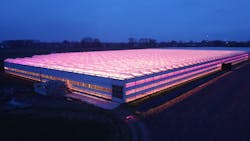The new LED lights at Belgian cherry tomato grower Tomerel could increase fruit yields even more than they have, except for one thing: The company has found that at certain times of the day and year, it is more lucrative to route electricity it generates onsite back to the grid.
Thus, in the wintertime, the Antwerp-based outfit tends to switch off its Fluence-supplied LED toplights in the late afternoon, when national electricity rates are high as people return home from work and settle in for the evening.
Instead, Tomerel feeds the grid with electricity, which is more profitable during those hours than the extra yields the company might garner for growing more tomatoes. The replacement of half of its comparatively inefficient high-pressure sodium (HPS) lights last summer with Fluence VYPR 3p fixtures has facilitated the maneuver.
Behold, then, another attribute of energy-efficient LED lighting: It can help your business double as an electricity provider while still improving your core operations.
“The electricity efficiencies enabled us to sell 25% more energy back to the grid,” said Tomerel CEO and co-owner Jelle de Ryck.
Tomerel generates electricity as well as heat onsite using a natural gas engine (not a boiler). The cogeneration scheme provides electricity for the lights, and furnishes the heat for hot water pipes that provide warmth in the winter. Tomerel also captures CO2 emissions from the process and funnels those into the growing environment.
“Because of the increased light level [180 µmol to 250 µmol], they are able to reach the desired DLI [Daily Light Integral] in fewer hours, which gives them the opportunity to sell electricity made by cogeneration back to the grid when electricity prices peak in the afternoon and evening,” Fluence horticultural specialist Gert-Jan Goes explained to LEDs Magazine. “They also have the opportunity to grow more tomatoes by increasing the amount of light [more hours] they give to the crop and adapt the way of growing. However, in the current situation, it’s more beneficial to sell the electricity in the peak hours instead of using this electricity to increase tomato production.”
What about the lighting benefits provided by the 50% replacement of HPS? According to Fluence, the efficiency of the LEDs has enabled Tomerel to increase lighting levels by 40% while decreasing energy consumption by 5%, improving yields by 5% and increasing tomato weight.
“We’re seeing improved quality and production throughout the winter months, and increases in stem density and improved translocation of sugars throughout the night,” Tomerel’s de Ryck noted. The LED power efficiencies have also led to a 5% reduction in the amount of gas Tomerel uses to generate electricity, he added.
In addition, the LEDs have provided what might be considered a counterintuitive winter heating advantage. Although Tomerel now relies more on the hot water pipes as a heat source than before the 50% HPS replacement — when the inefficient HPS emitted useful heat — the hot water is less expensive than electricity-driven HPS heat, Fluence’s Goes noted.
“In general, heat is less expensive compared to electricity,” he said.
On a related note, excess heat from HPS can be damaging or problematic to tomatoes in the fall and spring, so Tomerel now has the option to switch off HPS in those seasons. The two different light sources are arranged in a checkerboard pattern. Tomerel does not light the crops in the summer, when it taps only natural light.
Many growers who are adding LEDs to their mix have had to contend in one or another with the absence of HPS heat.
Does Tomerel plan to replace the remaining HPS lights with LED?
“No, the current European energy market is presenting challenges,” Fluence’s Goes told LEDs, referring to the state of astronomical energy prices. “Most likely in the upcoming winter, they will balance between lighting their crop at a low level and delivering as much electricity as possible back to the grid.”
Austin, TX–based Fluence is now a Signify business unit, following the early May closing of ams Osram’s December agreement to sell the company to Signify for $272 million in cash on a debt-free basis. It was part of ams Osram when it installed the lights at Tomerel last summer. The installation took two weeks.
MARK HALPER is a contributing editor for LEDs Magazine, and an energy, technology, and business journalist ([email protected]).
For up-to-the-minute LED and SSL updates, follow us on Twitter. You’ll find curated content and commentary, as well as information on industry events, webcasts, and surveys on our LinkedIn page and our Facebook page.







